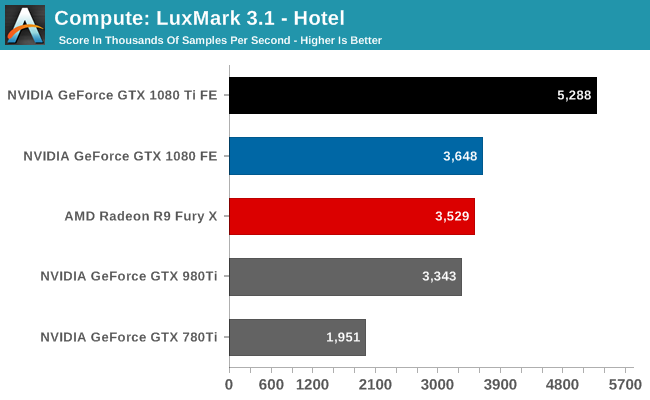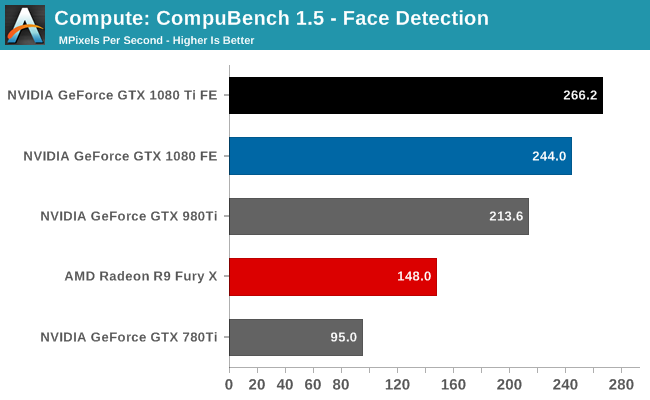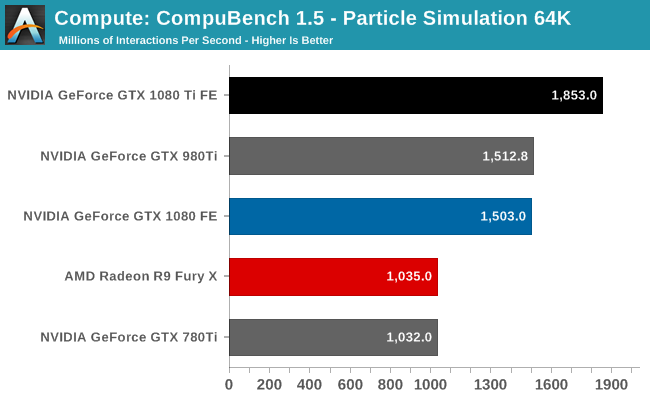The NVIDIA GeForce GTX 1080 Ti Founder's Edition Review: Bigger Pascal for Better Performance
by Ryan Smith on March 9, 2017 9:00 AM ESTCompute
Shifting gears, let’s take a look at compute performance on GTX 1080 Ti.
Starting us off for our look at compute is LuxMark3.1, the latest version of the official benchmark of LuxRender. LuxRender’s GPU-accelerated rendering mode is an OpenCL based ray tracer that forms a part of the larger LuxRender suite. Ray tracing has become a stronghold for GPUs in recent years as ray tracing maps well to GPU pipelines, allowing artists to render scenes much more quickly than with CPUs alone.

The OpenCL situation for NVIDIA right now is a bit weird. The company is in the middle of rolling out OpenCL 2.0 support to their video cards – something that I had actually given up hope on until it happened – and as a result their OpenCL drivers are in a state of flux as company continues to refine their updated driver. The end result is that OpenCL performance has dipped a bit compared to where the GTX 1080 launched at back in May, with said card dropping from 4138 points to 3648 points. Not that the GTX 1080 Ti is too fazed, mind you – it’s still king of the hill by a good degree – but the point is that once NVIDIA gets their drivers sorted out, there’s every reason to believe that NVIDIA can improve their OpenCL performance.
For our second set of compute benchmarks we have CompuBench 1.5, the successor to CLBenchmark. CompuBench offers a wide array of different practical compute workloads, and we’ve decided to focus on face detection, optical flow modeling, and particle simulations.



Like LuxMark, CompuBench shows some minor performance regressions on the GTX 1080 as compared to the card’s launch. None the less, this doesn’t do anything to impede the GTX 1080 Ti’s status as the fastest of the GeForce cards. It dominates every sub-benchmark, including Optical Flow, where the original GTX 1080 was unable to pull away from AMD’s last-generation Radeon R9 Fury X.










161 Comments
View All Comments
mapesdhs - Saturday, March 11, 2017 - link
Some 780 Ti owners may have oc'd their cards that high, but not many I suspect. I've been searching for 780 Ti cards for a while, for CUDA, most tend to be around 980MHz at best.mapesdhs - Saturday, March 11, 2017 - link
Also recall one model which was 1002MHz.Chaser - Thursday, March 9, 2017 - link
Glad to see I have no need for a card that powerful and expensive. I run a single 27" 2K IPS monitor and my Gigabyte Extreme gaming 1080 is more than enough to keep me on the high end for years to come. 4K is 90% bragging rights in terms of visible difference and also game developer support.sharath.naik - Thursday, March 9, 2017 - link
I think you may need to consider multi monitor gaming. Then this card makes sense if you want to use this in a small case that allows only one GPU.mapesdhs - Saturday, March 11, 2017 - link
Depends on the game and what kind of detail one likes. Site reviews and forum commentaries also don't take into account game mods which often significantly increase the GPU load (check out the OCN Best Skyrim Pics thread, have a look at the builds people are using).I like to play games with all details/settings at maxed out. Thus, such a card is very relevant. Sure, plenty of players don't mind if the fps drops to 30 or 40, but some like it smooth at a minimum. I've currently no interest in high frequency monitors (which ironically can sensitise one's vision anyway), but I do seek 60Hz minimum sync'd, something I can't get atm with a single 980 at 1920x1200. I plan on moving up to 4K soon; with a 1080 Ti, and likely being able to get away with turning of some of the AA options because of the higher pixel density (which regains performance), minimum 60Hz looks very possible.
It depends on one's needs; everyone has different thresholds of what they're happy with.
Chaser - Thursday, March 9, 2017 - link
Very well written, balanced review. Nicely done Ryan.BrokenCrayons - Thursday, March 9, 2017 - link
+1!nismotigerwvu - Thursday, March 9, 2017 - link
Quality work as always Ryan! I spotted a minor typo on the conclusions page "Because the GeForce GTX 1080 Tii Founder’s Edition isn’t NVIDIA’s first GP102-based product". Did a little midnight coffee spill and make that i key sticky? :)BrokenCrayons - Thursday, March 9, 2017 - link
Typo/Error also on Page 4 of the review in the line that reads:"For our review of the GTX 1060, we’re using NVIDIA’s 378.78 driver."
Probably should be "GTX 1080 Ti"
The table directly below that line is also missing the GTX 1080 Ti in the video cards section.
Ryan Smith - Thursday, March 9, 2017 - link
Thanks!